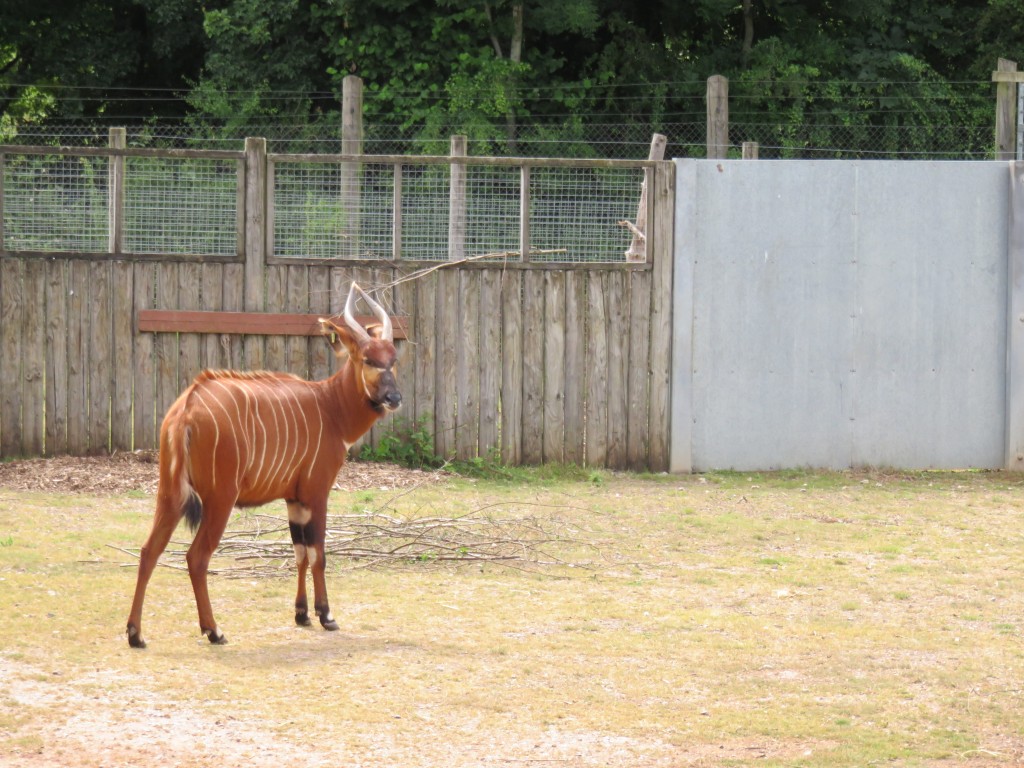Tom
While some of us have been lucky enough to escape the British weather and go abroad for our fieldwork, the rest of us have been getting stuck into our projects here in the UK. As my research is primarily desk based, I was one of those that stayed behind but that certainly didn’t mean missing out!
I’ll begin by introducing my research project: as some of you may be aware, Marwell Wildlife hosts the International Union for Conservation of Nature/Species Survival Commision’s (IUCN/SSC’s) Antelope Specialist Group (ASG) Programme Office. This means that a team from Marwell work with the ASG co-chairs to support their activities, update the IUCN Red List for 91 antelope species, and undertake research to help identify global antelope conservation priorities.

One of Marwell’s antelope species: the critically endangered Mountain Bongo (Tragelaphus eurycerus isaaci)
This is where my research comes in: the aim of my project is to gain an understanding of both the distribution of African antelope across protected areas and biomes, and an understanding of the socio-economic and ecological factors that contribute to antelope conservation status.
The starting point for my project was to establish what species I would look at. As the African continent is the most diverse region in terms of both antelope species richness and distribution, I decided that my research would focus solely on African antelope. Antelope are also of great importance within Africa and are often used as flagship species for biodiversity conservation.
With the species list created, the next step was to map distribution across protected areas and biomes, using ArcGIS and distribution data from the IUCN/SSC Red List, as well as data from the World Database on Protected Area (WDPA) and Terrestrial Ecosystems of the World (TEOW).
Socio-economic factors were then weighted according to antelope distribution and these values were input into a database alongside selected ecological traits taken from the literature. The end result of this process is a large database that now requires statistical analysis using some techniques that were completely new to me. This has resulted in a steep learning curve, but that’s why I’m on this Masters!
Aside from my research project I have been busy at both Marwell Wildlife and the University of Southampton. At Marwell, I’ve been filming big cat carcass feeds to assist with the long term research into big cat behaviour that last year’s cohort started. We’ve also been attending public engagement seminars hosted by the Marwell Education team, which have been really enlightening, and recently those who have been abroad on fieldwork gave presentations on their time in the field.
At the University, I’ve helped out at several “Mini bio-blitzes” at local schools, involving hosting several hour long sessions with Years 3-6. For those of you unfamiliar with the concept of a bio-blitz, the idea is to go out for a set period of time and identify as many species as possible. It was quite daunting leading some of these sessions knowing how much I knew about insects at that age! This week I will also be presenting a poster on my research project at the University of Southampton’s Post-Graduate Symposium, a great experience which should hopefully provide some useful feedback.
Looking ahead, I’ll be submitting an abstract for the 10th International Conference on Behaviour, Physiology and Genetics of Wildlife at the Leibniz Institute for Zoo and Wildlife Research that I’m attending with my supervisor in Berlin. This, I’m sure, will be a highlight of the year for me! We will also be attending (with some of us presenting) the South Downs Student Conference, as well as having a question and answer session with Marwell’s veterinary team, all of which I’m sure will be the subject of future posts!
Posted By : dvf1e13

